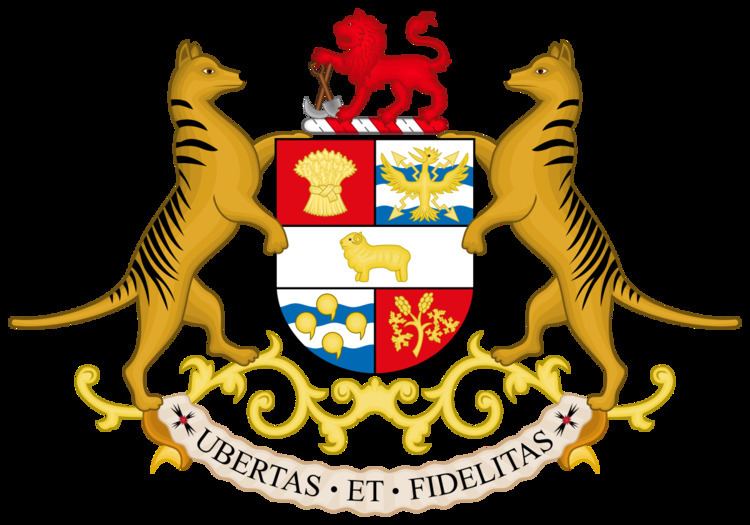Australian state Tasmania Meeting place Parliament House | Leader Premier | |
 | ||
Formation 1856 as responsible government;
1901 as an Australian state Legislature Parliament of Tasmania;
Tasmanian Legislative Council
Tasmanian House of Assembly | ||
The Government of Tasmania, also referred to as the Tasmanian Government, is the state democratic administrative authority of Tasmania. The Government of Tasmania, a parliamentary constitutional monarchy, was formed in 1856 as prescribed in its Constitution, as amended from time to time. Since the Federation of Australia in 1901, Tasmania has been a state of the Commonwealth of Australia, and the Constitution of Australia regulates its relationship with the Commonwealth.
Contents
- Executive and judicial powers
- Current Ministry
- House of Assembly
- Legislative Council
- Parliament House
- Tasmanian government agencies
- State owned businesses
- Federal representation of Tasmania
- Local government in Tasmania
- References
Under the Australian Constitution, Tasmania ceded certain legislative and judicial powers to the Commonwealth, but retained complete independence in all other areas. In practice, however, the independence of the Australian states has been greatly eroded by the increasing financial domination of the Commonwealth.
Executive and judicial powers
Tasmania is governed according to the principles of the Westminster System, a form of parliamentary government based on the model of the United Kingdom. Legislative power rests with the bicameral Parliament of Tasmania, which consists of the Crown, represented by the Governor of Tasmania, and the two Houses, the Tasmanian Legislative Council and the Tasmanian House of Assembly.
Executive power rests formally with the Executive Council, which consists of the Governor and senior ministers. In practice executive power is exercised by the Premier of Tasmania and the Cabinet, who are appointed by the Governor, but who hold office by virtue of their ability to command the support of a majority of members of the House of Assembly. Judicial power is exercised by the Supreme Court of Tasmania and a system of subordinate courts, but the High Court of Australia and other federal courts have overriding jurisdiction on matters which fall under the ambit of the Australian Constitution.
Current Ministry
The current ministry of Tasmania comprises the following nine Liberal members :
House of Assembly
Tasmania's House of Assembly is the lower house of the Tasmanian parliament. There are five House of Assembly divisions: Bass, Braddon, Denison, Franklin and Lyons. These divisions have the same boundaries as the five Commonwealth House of Representatives divisions for Tasmania. There are twenty-five members of the House of Assembly, with five members elected for each of the divisions using the Hare-Clark voting system of multi-member proportional representation. Members are elected for a term of up to 4 years.
Legislative Council
Tasmania's Legislative Council is the upper house of the Tasmanian parliament. It has 15 members, each representing one of the following 15 electoral divisions: Apsley, Montgomery, Rosevears, Derwent, Murchison, Elwick, Nelson, Rumney, Huon, Launceston, Wellington, Mersey, Pembroke, Western Tiers and Windermere. The boundaries of the current divisions are determined by the Legislative Council Redistribution Tribunal. Elections are conducted on a 6-year periodic cycle. Elections for 3 members are held in May one year, with elections for 2 members held in May the following year and so on.
Parliament House
Since 1841, both houses have met in Parliament House in Hobart. The building was originally intended as a customs house but changed use when Tasmania achieved self-government.
Tasmanian government agencies
The Tasmanian Government delivers services, determines policy and regulations, including legal interpretation, by a number of agencies grouped under areas of portfolio responsibility. Each portfolio is led by a government minister who is a member of the Parliament. As of April 2016 there were eight lead agencies, called government departments, that consist of:
A range of other agencies support the functions of these departments.
State-owned businesses
The Government of Tasmania also owns and operates a number of state-owned companies:
Federal representation of Tasmania
As a state of Australia, Tasmania is represented in the House of Representatives and Australian Senate. Tasmania has five representative in the federal House of Representatives in the divisions of Bass, Braddon, Denison, Franklin and Lyons. Tasmania also has twelve Senators in line with other states.
Local government in Tasmania
Local Government elections are conducted under the Local Government Act using the Hare-Clark voting system of multi-member proportional representation. Elections for Mayor, Deputy Mayor and half the councillor positions are held during September and October in each uneven numbered year. Tasmania has twenty-nine local government areas. These include six cities (three in greater Hobart, one covering each of Launceston, Burnie and Devonport) and twenty-three municipalities. The largest council (by number of enrolled electors) is City of Launceston and the smallest council is Municipality of Flinders (which serves the Flinders Island and surrounding islands, and has just over 800 electors)
